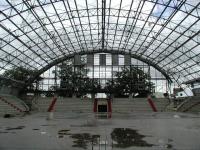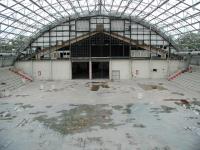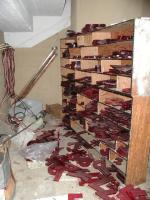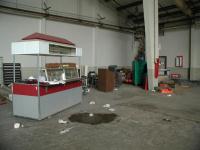
City Coliseum right before the demolition.
Near the southern shore of Town Lake, City Coliseum looked more like an aircraft hanger than a special events center. The reason for that is that is WAS an aircraft hanger, at least until the city of Austin purchased the structure from the US government in 1940 and converted it. The homely old building would go on to host many a gathering over the years and saw some up and coming artists play there.

Demolished front corner.
In recent years the number of events staged there had dwindled as other venues sprang up. The nearby Palmer Auditorium, Austin Convention Center and even the Burger Center presented a nicer surrounding than the aging hanger. In recent years the city-wide garage sale and Carnival Austin were the major users of the facility.
With the city of Austin's plan for a revitalized Palmer Auditorium and a new special events center the need for Palmer Coliseum was no more. The master plan for the area included the demolition of the Coliseum and returning the land to green space since the new parking garage at Palmer Auditorium removed the need for the parking lot around the Coliseum.

The main hall of the Coliseum looking toward the main entrance.
The last event to be held at the Coliseum was the Austin Lyric Opera's production of "Rigoletto" on May 20, 2002. The performance attempted to make special use of the cavernous main hall to full measure in a grand finale befitting the years of service provided by the center.

The main hall looking towards the back of the building.
The destruction of City Coliseum did not raise any outcry. It certainly was not an attractive building and though it
possessed a multitude of stories and memories it could not really be termed historic by any reasonable definition. Still, some Austinites had some attachment to the place and the city saw a way to satisfy citizen interest and fiscal responsibility. So, on Saturday, October 19, 2002 the city and demolition company held an open house and sold for bottom dollar anything that was not bolted down. Well, anything that was not bolted down too tightly. A section of one of the brick walls was knocked down and bricks were made available for the taking.

This control panel was used for many performances in the Coliseum, but no more.
Foul weather on that weekend may have cut down on the number of bargain seekers. When we visited the wrecking site on Sunday, October 20 we expected to be able to do nothing more than take pictures from a distance. Instead we found the facility to be wide open with not a "no trespassing" sign in site. So we explored the building and found many unclaimed items spread around the building.

We hope that this interesting, old safe did not end up in a landfill.
The Coliseum must have served as storage area for the University of Texas in addition to other organizations since the back of the building contained stacks of old desks, bookcases, filing cabinets and even office doors. Some cabinets still contained academic papers and doors even included office hours. The recent rains made getting to many of the desks and bookcases an extremely muddy proposition and a shame since we fear many of these solid wood desks ended up in a landfill.
The most interesting spot on our exploration was the main hall. Demolition crews had removed the metal roof but left the arched support beams in place. The middle of the hall resembled the stomach cavity of a large fossilized dinosaur with the rib cage towering overhead.

The large red letters were used to fill out the coliseum's sign along Riverside to let passersby know what event was coming.
Under the seats of the main hall were the bathrooms, storage, ticket booths, concession booths and support rooms. The Audio/Visual room contained an empty equipment rack. One support room contained the stash of red plastic letters that workers used to announce the upcoming events on the Coliseum's large sign along Riverside Drive. We also found empty speaker boxes, mounds of dinner linens and an extremely large safe.

Do you want fries with that?
Yes, a safe. Standing perhaps 6 feet tall, this wheeled, but immobile monster struck us as old, though we could not discern any date of manufacture on its surface. The doors were locked shut but the combination dials seemed to be in working order. The impressive size of the safe and its weathered, historic appearance made us a bit sad to think that some antique dealer
did not snatch up this piece and save it from the landfill. Penny wanted to take it home, but we had none of the vehicle with which to move it, a place in which to put it, nor the certain legal go-ahead to make such a move even if we the other issues could be addressed.
When we passed by the old coliseum in early 2003 all that remained was rubble and two air vents that mysteriously were left standing. The rubble was in the process of being hauled away and the vents too would be gone shortly.
Sources:
Kevin Dytrich